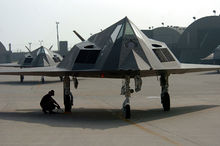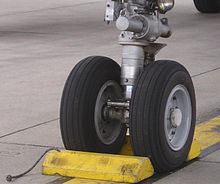- Chock (wheel)
-
For other uses, see Chock (disambiguation).Wheel chocks placed around an aircraft's landing gear.

 Chocks being removed from a British Airways Airbus A321.
Chocks being removed from a British Airways Airbus A321.
 An Airman prepares to pull the landing gear wheel chock of an F-117 Nighthawk fighter during an end of runway check at Kunsan Air Base, South Korea.
An Airman prepares to pull the landing gear wheel chock of an F-117 Nighthawk fighter during an end of runway check at Kunsan Air Base, South Korea.
Wheel chocks (or chocks) are wedges of sturdy material placed behind a vehicle's wheels to prevent accidental movement. Chocks are placed for safety in addition to setting the brakes. The bottom surface is sometimes coated in rubber to enhance grip with the ground. For ease of removal, a rope may be tied to the chock or a set of two chocks. One edge of the wedge has a concave profile to contour to the wheel and increase the force necessary to overrun the chock. Most commonly, chocks are seen on aircraft and train cars.
Automobiles usually have parking brakes on the rear wheels. If the rear axle is jacked off the ground with only the parking brake set, the vehicle may roll on the front wheels and fall. Chocking the front wheels prevents this mishap.
Motorcycle and bicycle chocks are bifurcated and fit around the wheel, supporting the bike and preventing its movement.
The mining industry uses wheel chocks to protect lubrication trucks and heavy maintenance vehicles from slipping on off-road terrain when placed in Park. The huge haul trucks, which can weigh up to a million pounds, require a much larger wheel chock that itself will weight almost 80 pounds. These circumstances will benefit from urethane wheel chocks that are lightweight enough to be maneuvered, yet can withstand the responsibility of holding a truck if a brake should fail. The Mine Safety and Health Administration (MSHA) has established standards that wheel chocks are used when a vehicle is parked on a grade, and OSHA has guidelines that require wheel chocks during loading or unloading of a heavy truck.
How to use wheel chocks
- To use wheel chocks, they must be selected to match the size of the tires on the vehicle, and used in pairs.
- Use the wheel chocks on a firm surface - some rubber wheel chocks have steel grates and ice cleat accessories.
- Place the vehicle in Park and apply the parking/emergency brake.
- Position wheel chocks snugly against the center of the tire, in the direction of the grade.
- Chock both of the tires in the direction of the grade.
- If the vehicle is on a flat surface, chock on both sides of the tire, and use two sets of chocks.
- The above ruling is especially helpful if the vehicle will be undergoing engine work or is being loaded or unloaded with the engine running.
- Make sure the chocks meet holding requirements, improperly used chocks can result in product failure.
Parking chocks
A parking space commonly contains a parking chock, a barrier which is used to prevent cars from pulling too far into the space and obstructing a neighboring parking space, curb, or sidewalk.
This barrier, also called a parking stop, is usually made of concrete or recycled plastic and will normally be a horizontal bar to stop the tires from moving forward or a vertical bar that may cause damage to the vehicle if contact is made. In a parking garage, the barrier will often be a concrete wall. The recycled plastic parking stops are more lightweight than concrete and will not crack or chip. This lighter version can be installed with one person and will resist auto oils and fuels and will never need maintenance such as re-painting.
External links
 Media related to Wheel chocks at Wikimedia Commons
Media related to Wheel chocks at Wikimedia Commons
This tool article is a stub. You can help Wikipedia by expanding it.

